Experimental Study of Shear Performance of High-Strength Concrete Deep Beams with Longitudinal Reinforcement with Anchor Plate
Abstract
:1. Introduction
2. Test Overview
2.1. Specimen Design
2.2. Experiment Material
2.3. Loading System and Data Collection
3. Experiment Results and Analyses
3.1. Experiment Failure Process
3.2. Experiment-Failure Mode
3.3. Experiment Damage Results
3.4. Mid-Span Deflection Curve
3.5. Crack-Width Curve of Oblique Section
3.6. Steel-Strain Curve
3.6.1. Average-Strain Curve of Longitudinal Reinforcement
3.6.2. Average-Strain Curve of Horizontal Reinforcement
3.7. Concrete-Strain Curve
4. Results
4.1. Codes of Every Country
4.2. Tan–Tang Model and Tan–Cheng Model
4.3. SSTM and SSSTM
4.3.1. SSTM
4.3.2. SSSTM
4.4. Results and Analysis
5. Conclusions
- The failure process of the specimens was the same, and the failure mode was the diagonal compression failure of the concrete strut crushing, showing obvious brittle failure. The cracking load of the normal section was about 15~20% of the ultimate load, and the cracking load of the inclined section was about 30~40% of the ultimate load. The shear span ratio had a significant effect on the failure mode of deep beams.
- The shear span ratio is an important factor affecting the ultimate bearing capacity of deep beams. When the shear span ratio increased from 0.3 to 0.9, the bearing capacity decreased by 32.9%. The longitudinal reinforcement ratio had no obvious effect on the cracking load of the normal section of the specimen, but had a significant effect on the cracking load and ultimate load of the inclined section. When the longitudinal reinforcement ratio increased from 0.67% to 1.05% and 1.25%, the ultimate load increased by 18.2% and 42.6%, respectively. The increase in longitudinal reinforcement ratio can increase the bearing capacity of concrete.
- The reinforcement ratio of the web reinforcement will also have an impact on the bearing capacity of the deep beam. The steel skeleton formed by the combination of horizontal reinforcement and stirrups can effectively constrain the strain of the concrete, improve the ductility of the deep-beam member, and increase the effective cross-sectional area and strength of the concrete pressure bar, and the web reinforcement can also be used as a force-transmission path to improve the bearing capacity of the component. The increase in the reinforcement ratio of the web reinforcement can reduce the concrete strain, thereby reducing the width of the inclined crack. The web reinforcement is the same as the longitudinal reinforcement, which had little effect on the cracking load of the component, and the restraint effect on the concrete did not increase linearly;
- The shear bearing capacity of reinforced concrete deep-beam specimens was calculated by using the calculation method recommended by the specification and the Tan–Tang model, Tan–Cheng model, SSTM, and SSSTM based on the strut-and-tie model. The results showed that the ACI318-19 code was similar to the test results, and the Chinese code has a greater safety reserve. The model proposed by Professor Tan takes into account the size effect and the data deviation was small. The calculation results of the softened strut-and-tie model method were close to the experimental results. The softened strut-and-tie model considers the softening effect of the concrete strut bar, and has a clear mechanical calculation model, which can reasonably reflect the stress mechanism of the components.
Author Contributions
Funding
Institutional Review Board Statement
Informed Consent Statement
Data Availability Statement
Conflicts of Interest
References
- Lu, W.Y.; Lin, I.J.; Yu, H.W. Shear strength of reinforced concrete deep beams. ACI Struct. J. 2013, 110, 671–680. [Google Scholar]
- Shuraim, A.B.; El-Sayed, A.K. Experimental verification of strut and tie model for HSC deep beams without shear reinforcement. Eng. Struct. 2016, 117, 71–85. [Google Scholar]
- Demir, A.; Caglar, N.; Ozturk, H. Parameters affecting diagonal cracking behavior of reinforced concrete deep beams. Eng. Struct. 2019, 184, 217–231. [Google Scholar]
- Zhang, J.H.; Li, S.S.; Xie, W.; Guo, Y.D. Experimental Study on Shear Capacity of High Strength Reinforcement Concrete Deep Beams with Small Shear Span–Depth Ratio. Materials 2020, 13, 1218. [Google Scholar] [PubMed]
- Li, S.S.; Wu, Z.W.; Zhang, J.H.; Xie, W. Experimental Study and Calculation Methods of Shear Capacity for High-Strength Reinforced Concrete Full-Scale Deep Beams. Materials 2022, 15, 6017. [Google Scholar]
- Wu, T.; Wei, H.; Liu, X. Shear Behavior of Large-Scale Deep Beams with Lightweight-Aggregate Concrete. ACI Struct. J. 2020, 117, 75–89. [Google Scholar]
- Wu, T.; Wei, H.; Liu, X. Experimental investigation of shear models for lightweight aggregate concrete deep beams. Adv. Struct. Eng. 2017, 21, 109–124. [Google Scholar]
- Ye, L.P.; Meng, J.; Wang, Y.H. Application of Strut-and-tie Model in Design of Reinforced Concrete Deep Beams. J. Archit. Civ. Eng. 2009, 26, 81–86. [Google Scholar]
- Macgregor, J.G.; Wight, J.K. Prentice Hall. In Reinforced Concrete: Mechanics and Design, 7th ed.; Pearson Education South Asia: Singapore, 2006; Volume 7, pp. 154–187. [Google Scholar]
- Quintero, F.C.G.; Parra, M.G. Strength of struts in deep concrete members designed using strut-and-tie method. ACI Struct. J. 2006, 103, 577–586. [Google Scholar]
- Liu, X.; Wang, J.; Wu, T.; Wei, H. Significance Analysis of Influence Parameters on Shear Capacity of Deep Flexural Member. Eng. Mech. 2017, 34, 126–135. [Google Scholar]
- Tan, K.H.; Teng, S.; Kong, F.K.; Lu, H.Y. Main Tension Steel in High Strength Concrete Deep and Short Beams. ACI Struct. J. 1997, 94, 752–768. [Google Scholar]
- Oh, J.K.; Shin, S.W. Shear strength of reinforced high-strength concrete deep beams. ACI Struct. J. 2001, 98, 164–173. [Google Scholar]
- Chen, B.Q.; Zeng, L.; Liu, C.J.; Mo, J.X. Study on Shear Behavior and Bearing Capacity of Steel Reinforced Concrete Deep Beams. Eng. Mech. 2022, 39, 215–224. [Google Scholar]
- Jin, L.; Lei, Y.S.; Du, X.L. Comparison of size effect in shear failure of BFRP and steel-reinforced concrete deep beams. China Civ. Eng. J. 2022, 55, 55–66. [Google Scholar]
- Tan, K.H.; Kong, F.K.; Teng, S.; Weng, L.W. Effect of Web Reinforcement on High Strength Concrete Deep Beams. ACI Struct. J. 1997, 94, 572–582. [Google Scholar]
- Singh, B.; Vimal, A.; Gaurav, G. Whither Transverse Reinforcement in Bottle-shaped Struts? Structures 2018, 14, 43–55. [Google Scholar]
- Mihaylov, B.I.; Bentz, E.C.; Collins, M.P. Behavior of Large Deep Beams Subjected to Monotonic and Reversed Cyclic Shear. ACI Struct. J. 2010, 107, 726–734. [Google Scholar]
- GB50010–2010; Design Code for Concrete Structures. China Construction Industry Press: Beijing, China, 2010.
- Liu, L.X.; Xie, L.L.; Chen, M. Research on the Shear Performance of Reinforced Concrete Deep Bending Components. Build. Struct. 2000, 30, 19–22. [Google Scholar]
- Shi, X.F.; Su, C.; Qiu, Z.X.; Sun, X.D.; Song, J. Study on Shear Behavior of Prestressed Concrete T-beams with T-headed Vertical Reinforcement. China Civ. Eng. J. 2023, 1, 1–13. [Google Scholar]
- Miao, T.; Zheng, W.; Wang, Y.; Zhou, Y. Local Bearing Capacity of Concrete Under the Interaction of Headed Bars. Int. J. Struct. Stab. Dyn. 2022, 22, 2240003. [Google Scholar]
- Sim, H.J.; Chun, S.C. Side-Face Blowout Strength of Two-Layer Headed Bars Embedded in Exterior Beam-Column Joints. ACI Struct. J. 2022, 119, 221–231. [Google Scholar]
- Chen, H. Study of Shear Mechanisms and Strength of Concrete Deep Beams Based on Strut-and-Tie Model. Ph.D. Thesis, Hunan University, Changsha, China, 2019. [Google Scholar]
- Mitchell, D.; Collins, M.P. Diagonal compression field theory-a rational model for structural concrete in pure shear torsion. ACI Struct. J. 1974, 71, 396–408. [Google Scholar]
- Mau, S.T.; Hsu, T.T.C. Shear strength predication for deep beams with web reinforcement. ACI Struct. J. 1987, 84, 318–329. [Google Scholar]
- ACI Committee 318. Building Code Requirement for Structural Concrete and Commentary; American Concrete Institute: Farmington Hills, MI, USA, 2019. [Google Scholar]
- The European Standard EN 1992-1-1:2004, Eurocode 2; Design of Concrete Structures. British Standards Institution: Brussels, Belgium, 2004.
- CSA A23.3-19; Design of Concrete Structures. Canadian Standards Association: Mississauga, ON, Canada, 2019.
- Tang, C.Y.; Tan, K.H. Interactive Mechanical Model for Shear Strength of Deep Beams. J. Struct. Eng. 2004, 130, 1534–1544. [Google Scholar]
- Tan, K.H.; Cheng, G.H. Size Effect on Shear Strength of Deep Beams: Investigating with Strut-and-Tie Model. J. Struct. Eng. 2006, 135, 673–685. [Google Scholar]
- Hwang, S.J.; Lu, W.Y.; Lee, H.J. Shear Strength Prediction for Deep Beams. ACI Struct. J. 2000, 97, 367–376. [Google Scholar]
- Hwang, S.J.; Lee, H.J. Strength Prediction for Discontinuity Regions by Softened Strut-and-Tie Model. J. Struct. Eng. 2004, 130, 530–531. [Google Scholar]
- Wu, T.; Wei, H.; Liu, X. Shear Analysis of Deep Flexural Member Based on Crack Band Theory. Eng. Mech. 2017, 24, 92–100. [Google Scholar]
- Kondalraj, R.; Rao, G.A. Experimental investigation of RC deep beams with web reinforcement and improvement of ACI 318–19 strut coefficient–ScienceDirect. Structures 2021, 32, 914–928. [Google Scholar] [CrossRef]
- GB50152-12; Standard for Test Method of Concrete Structures. China Architecture & Building Press: Beijing, China, 2012.
- GB/T50081-2002; Standard for Test Methods of Mechanical Properties of Ordinary Concrete. China Architecture & Building Press: Beijing, China, 2002.
- GB/T228.1-2010; Tensile Testing of Metallic Materials Part 1: Test Methods at Room Temperature. China Architecture & Building Press: Beijing, China, 2010.
- Juan, D.; Lubell, A.S. Behavior of Concrete Deep Beams with High Strength Reinforcement. In Structures Congress 2008: Crossing Borders; American Society of Civil Engineers: Reston, VA, USA, 2008. [Google Scholar]
- Windisch, A. Minimum Web Reinforcement in Deep Beams. ACI Struct. J. 2014, 100, 297–306. [Google Scholar]
- Tan, K.H.; Lu, H.Y. Shear behavior of large reinforced concrete deep beams and code comparisons. ACI Struct. J. 1999, 96, 836–845. [Google Scholar]

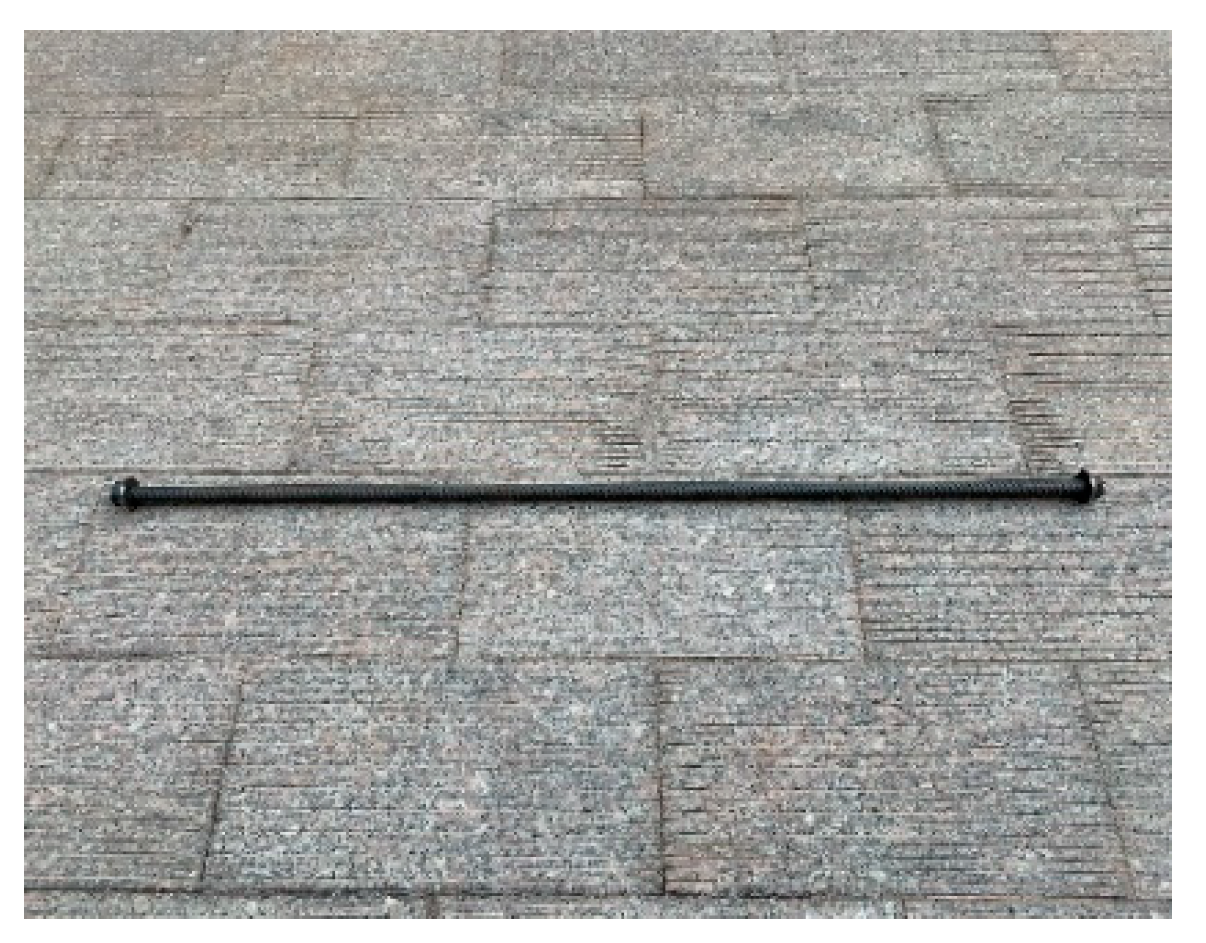

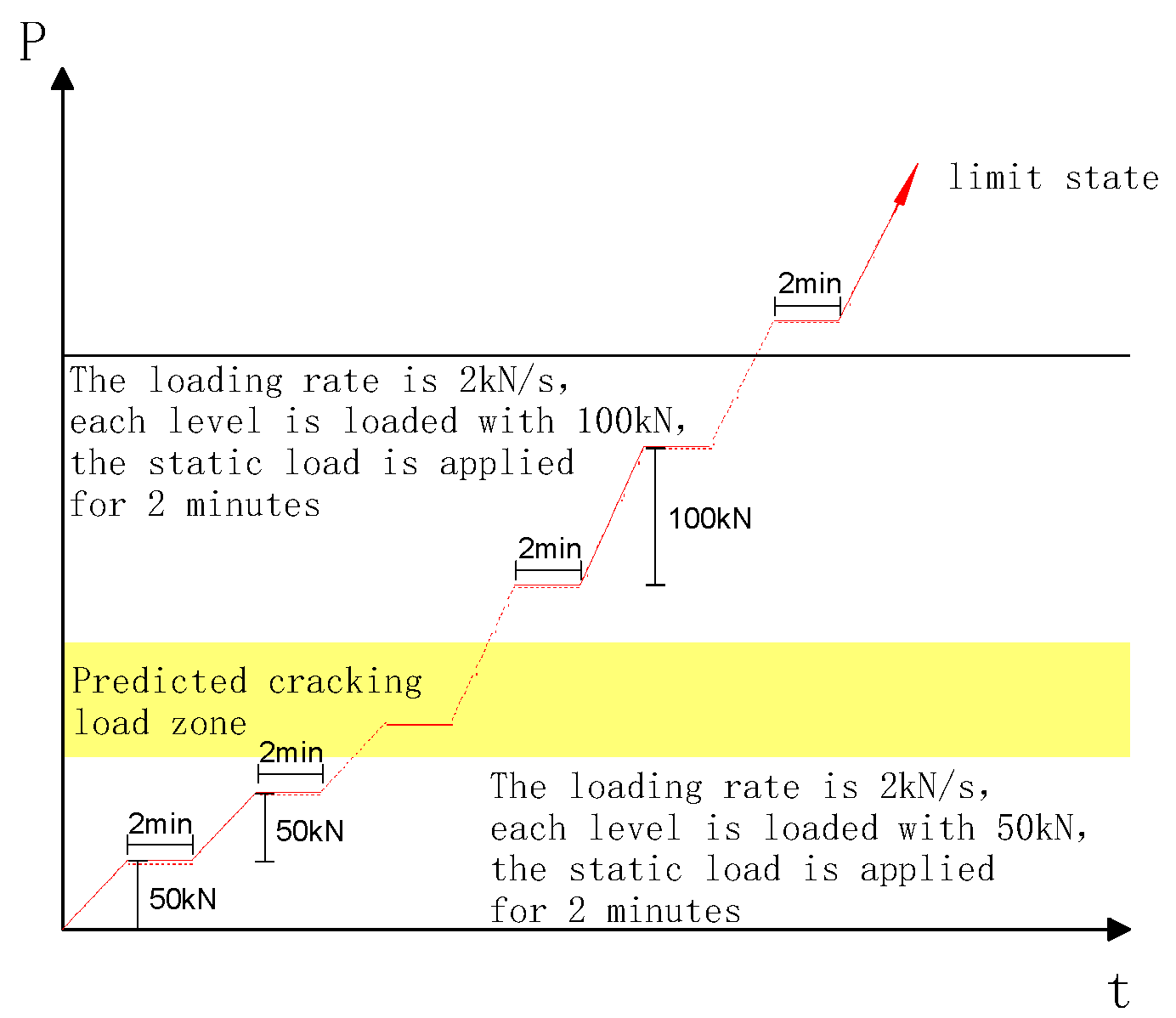
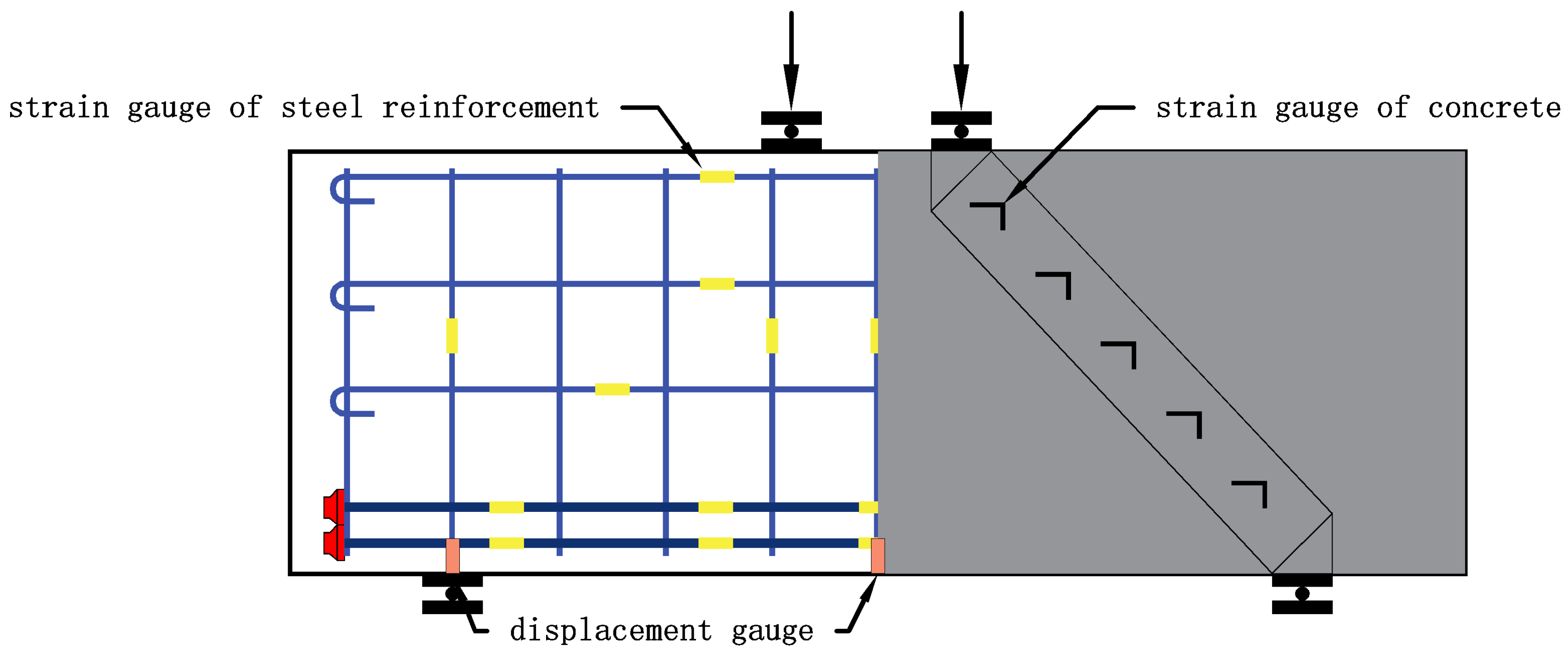


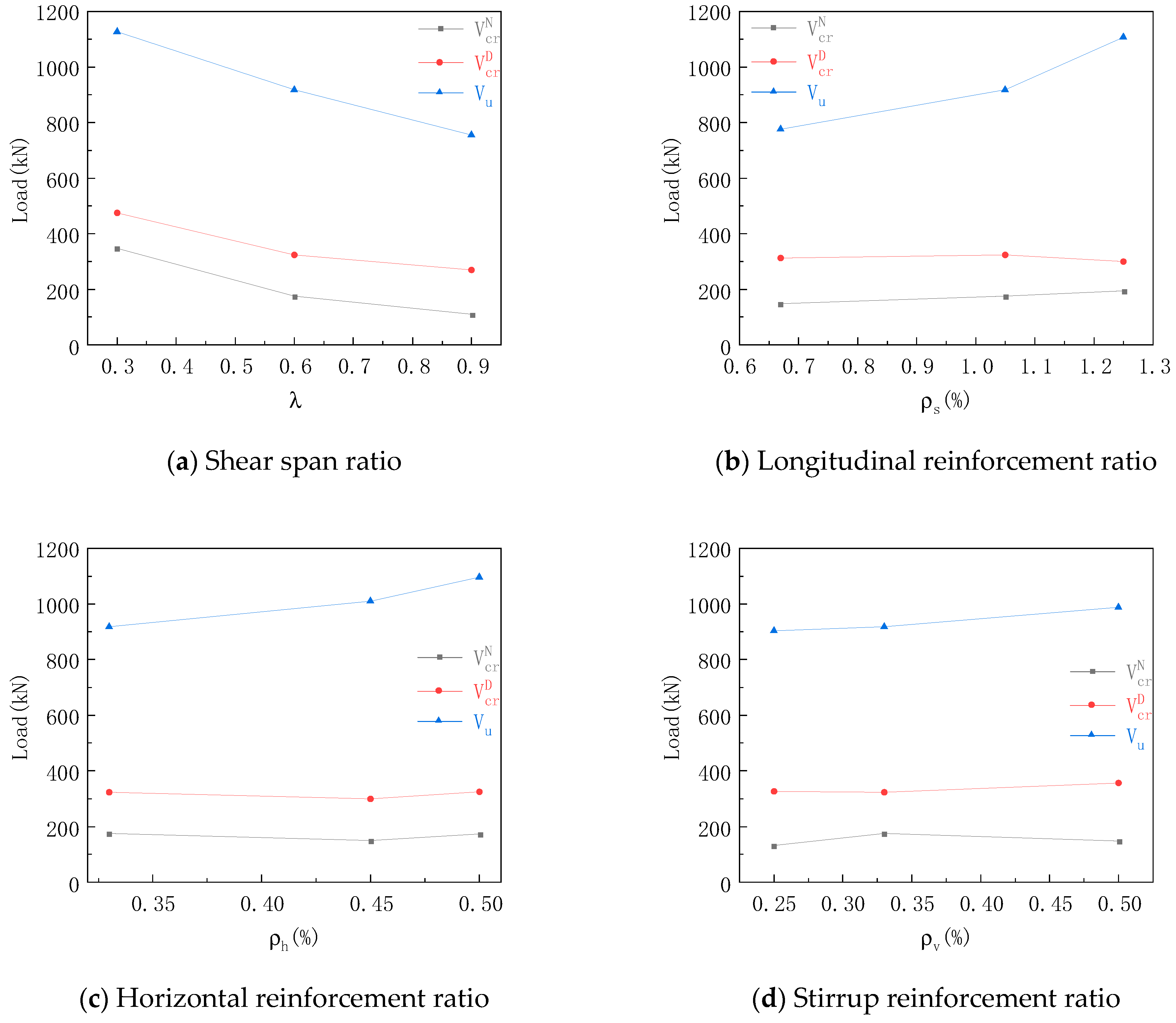
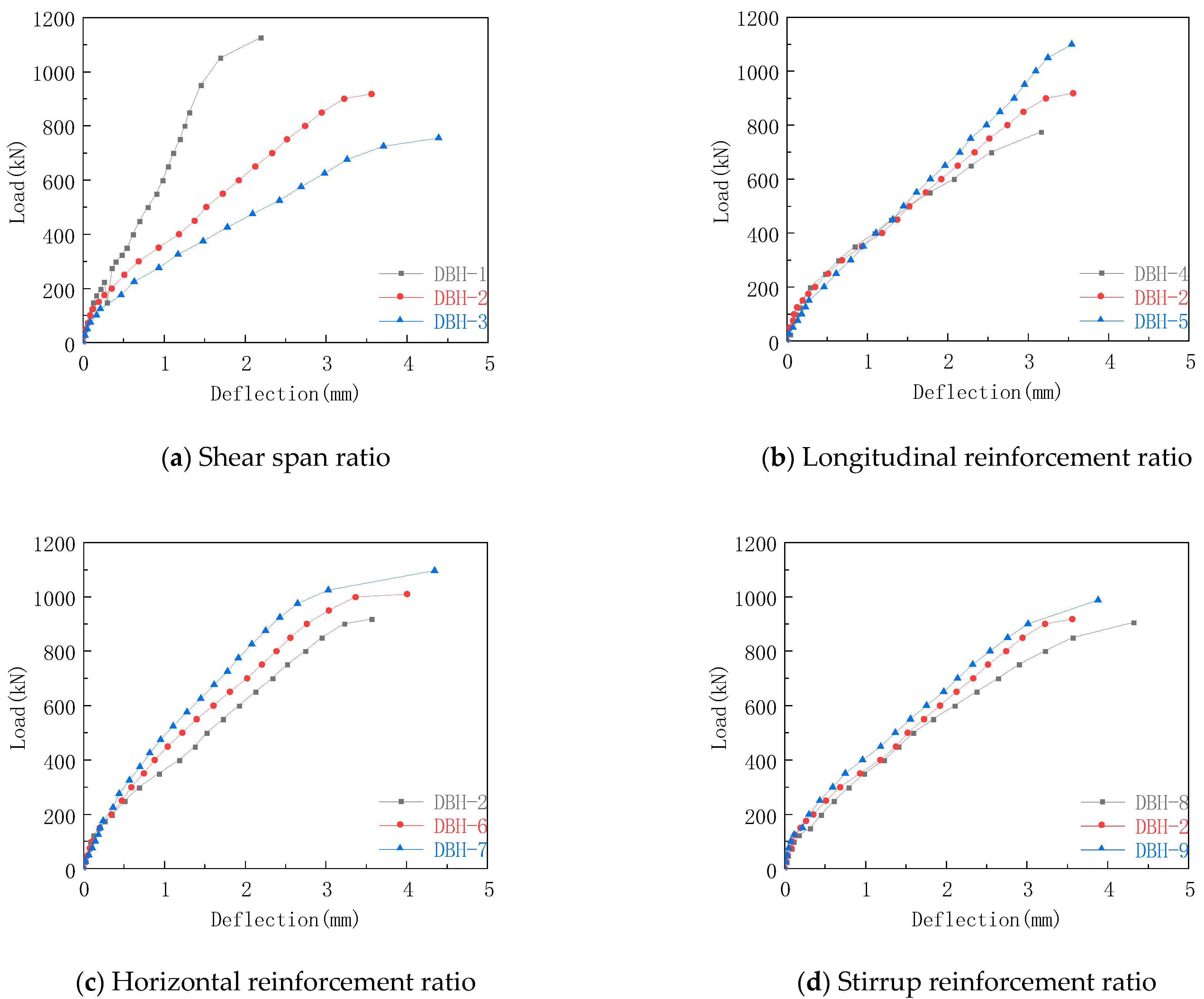
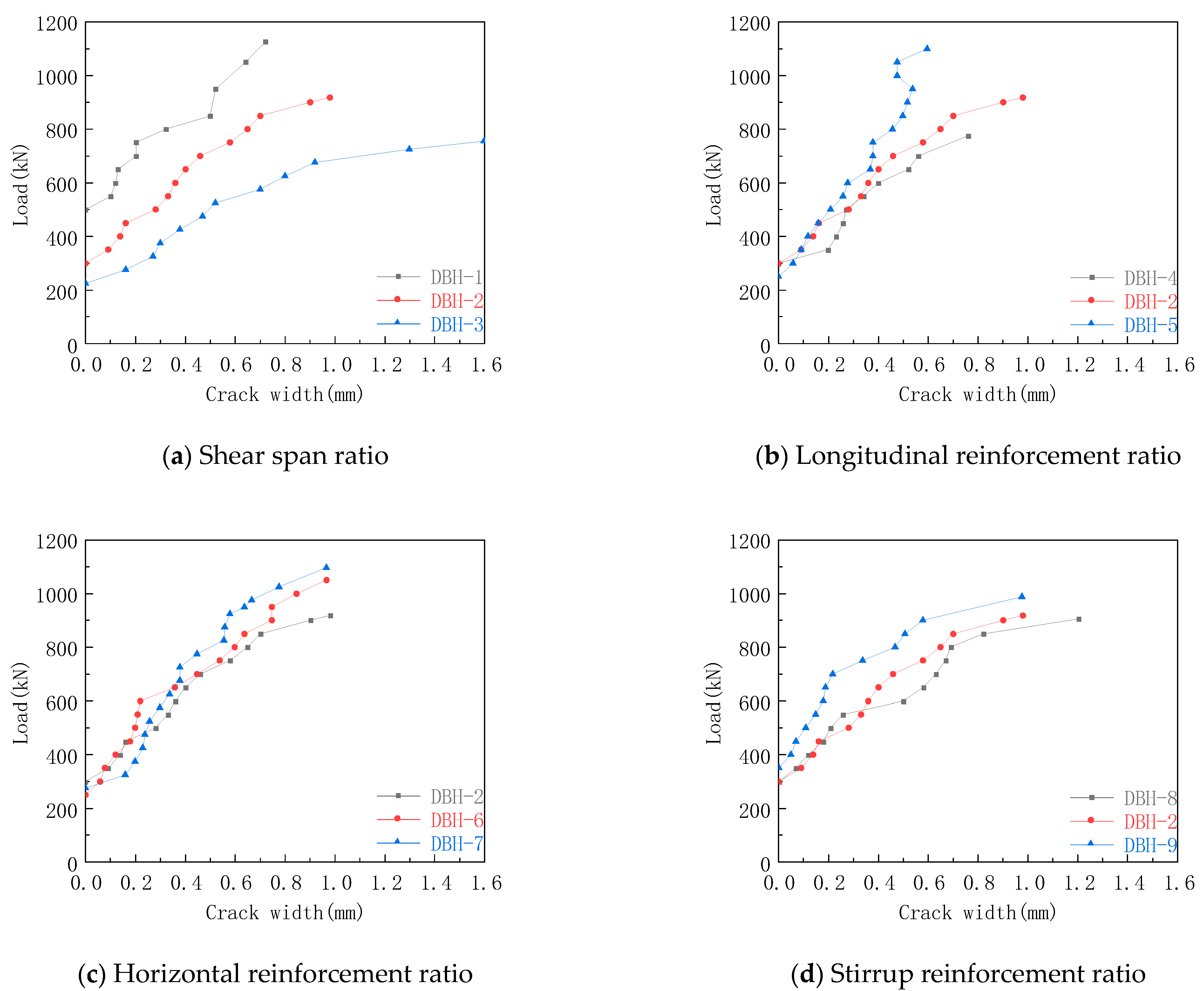
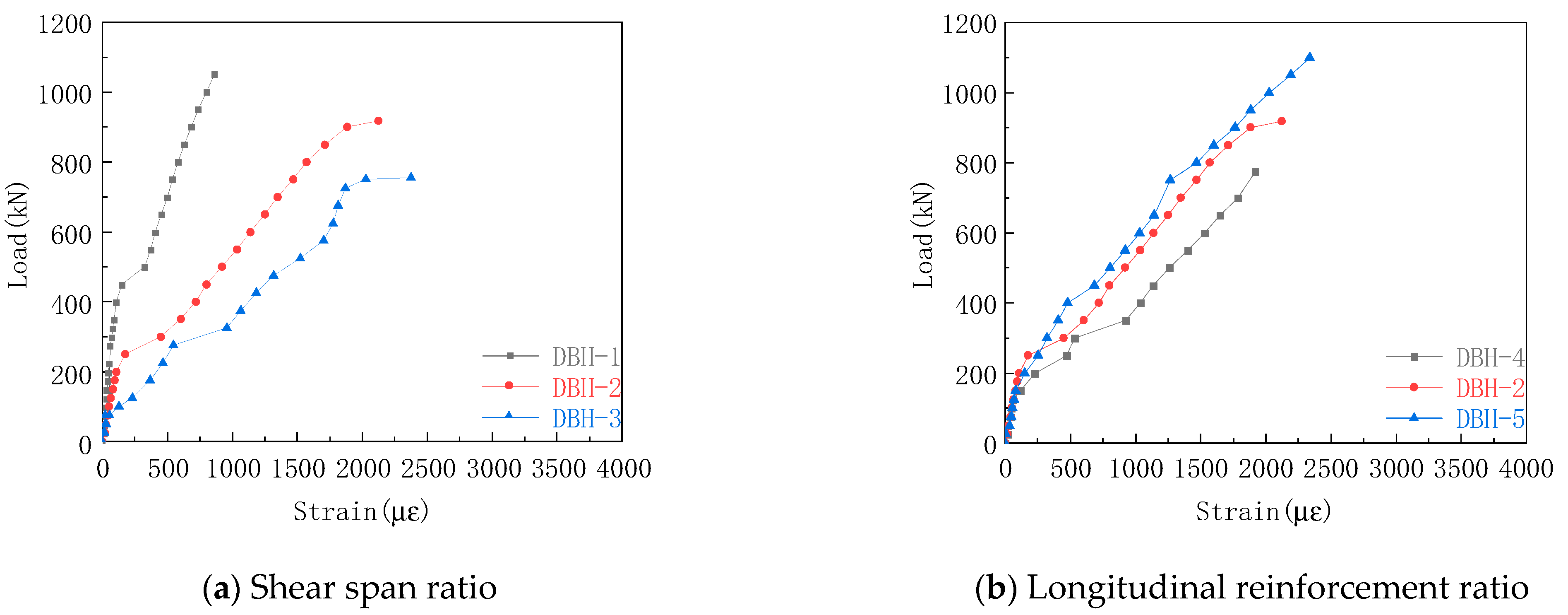
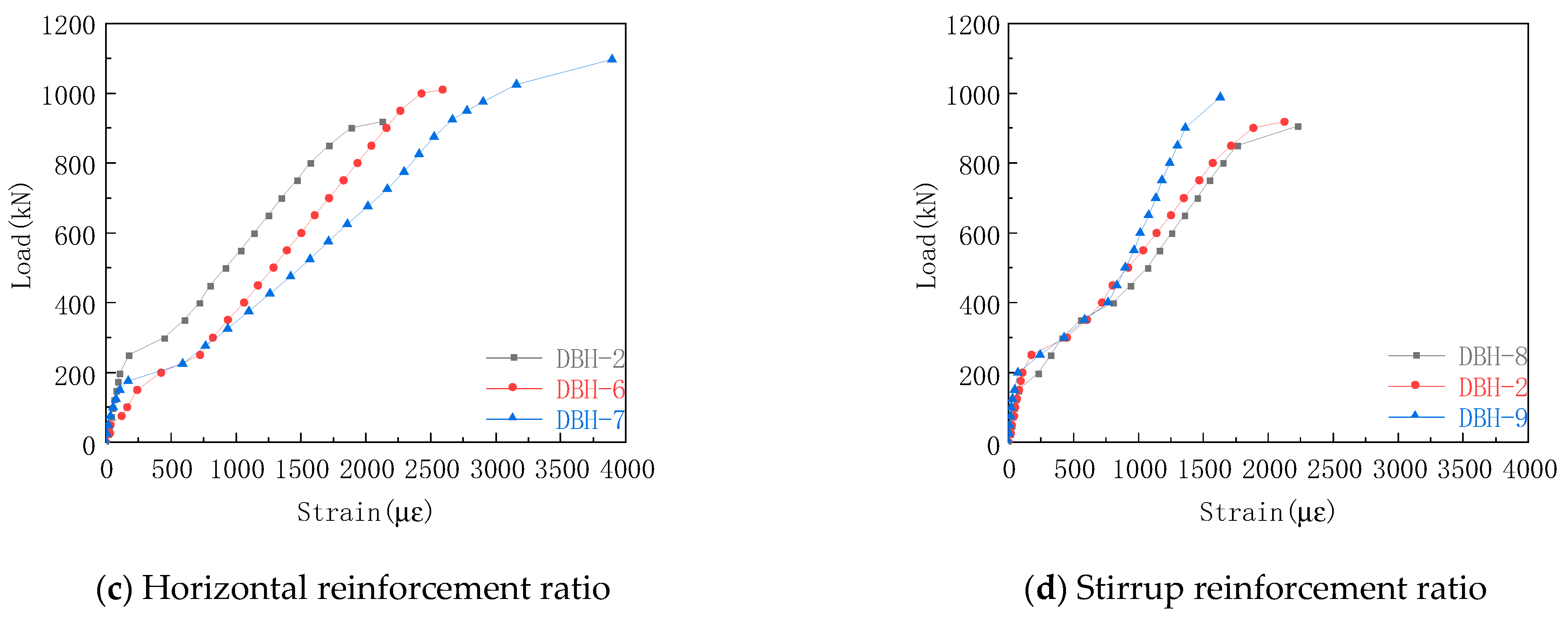

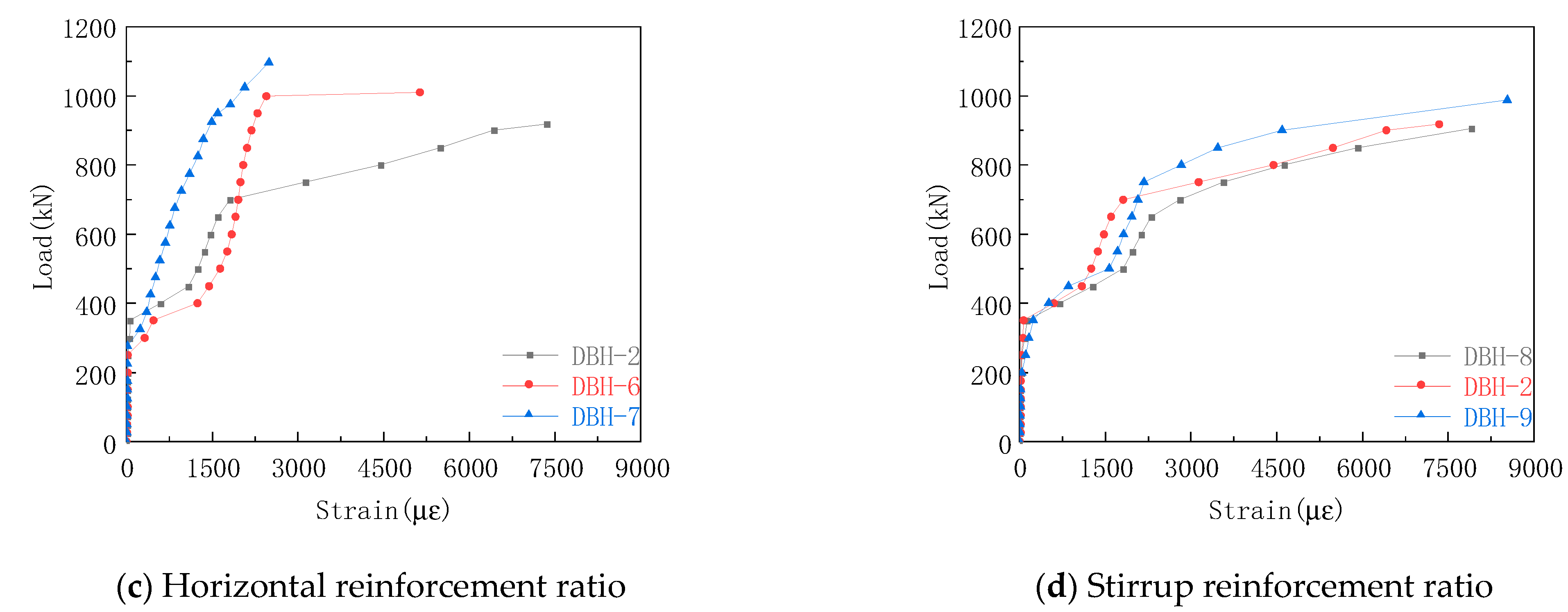
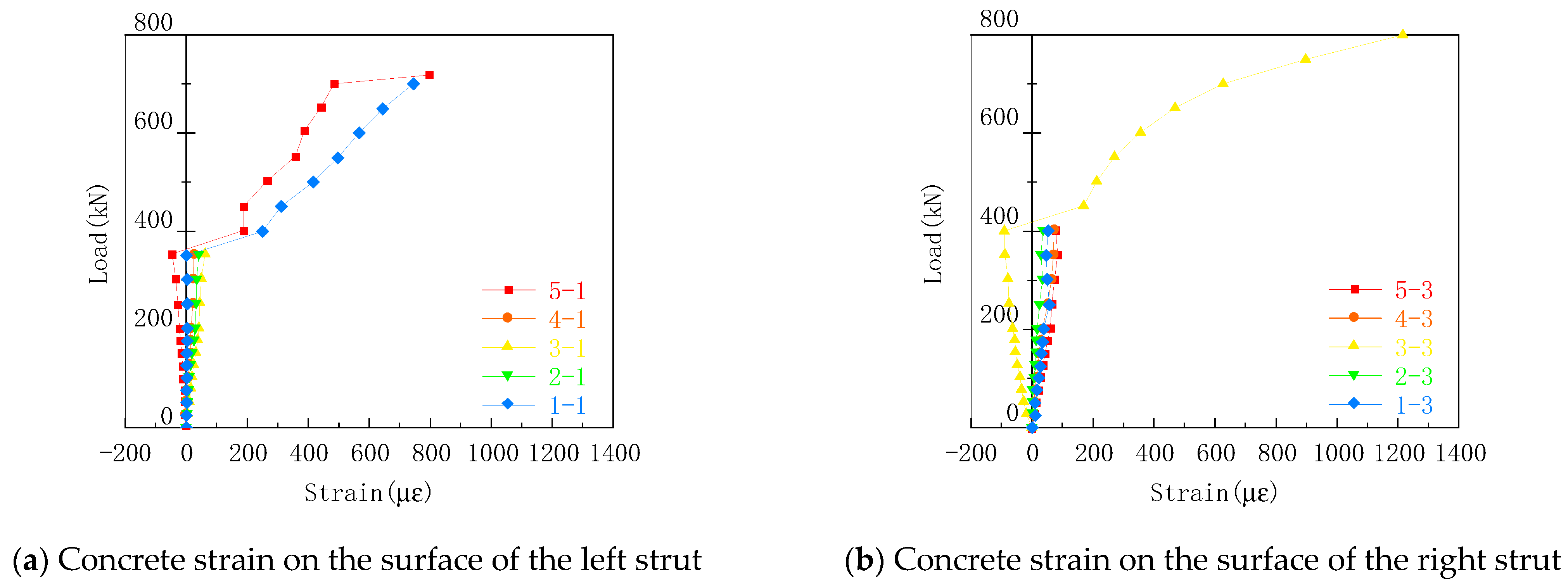
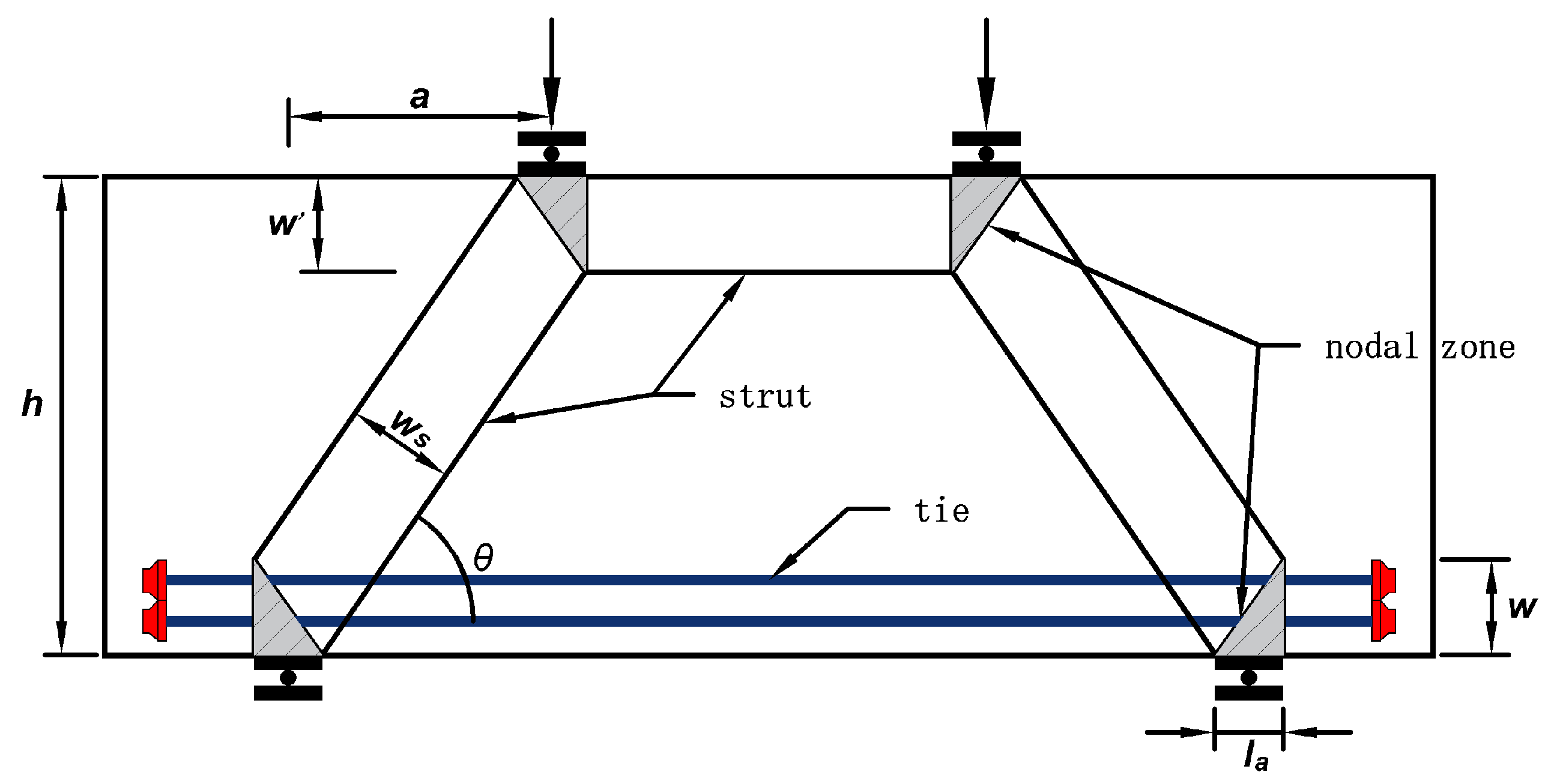
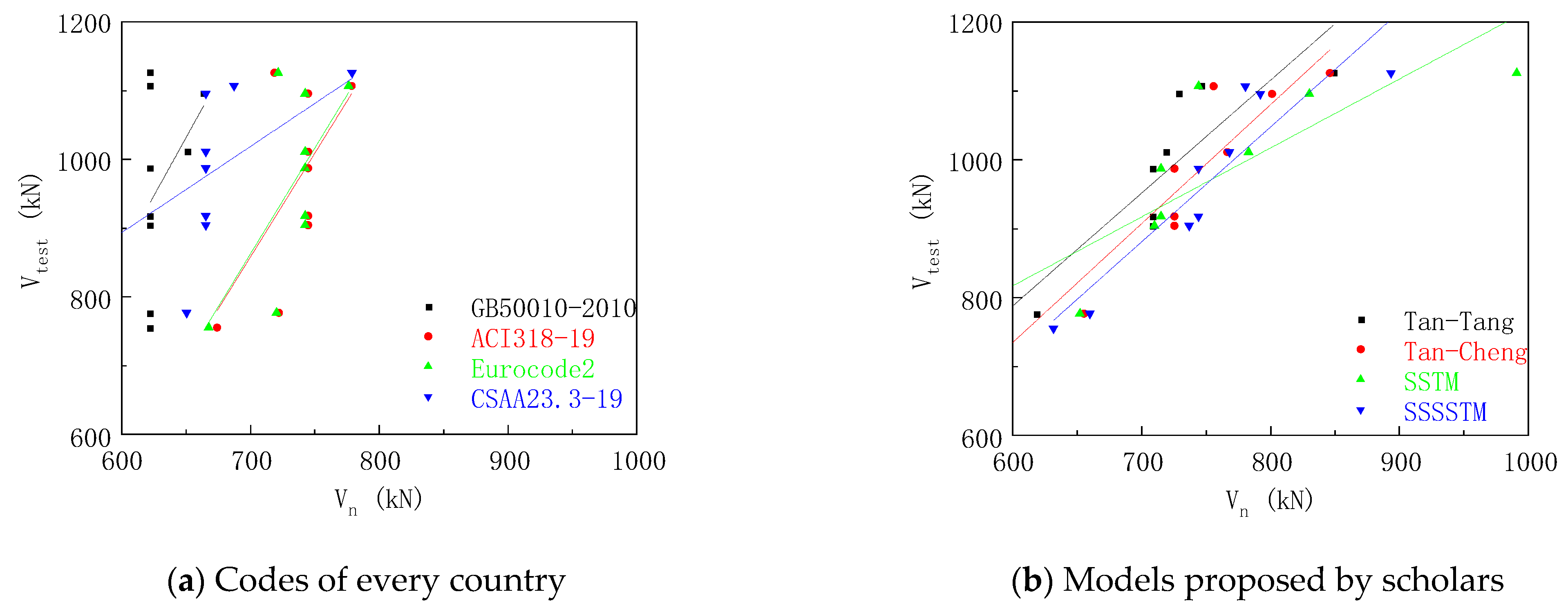
| Specimen Number | Parameters of the Specimen | Longitudinal Reinforcement | /% | Horizontal Reinforcement | /% | Stirrup Reinforcement | /% | Anchor Plate Diameter/mm | |
|---|---|---|---|---|---|---|---|---|---|
| DBH-1 | DBH-0.3-1.05-0.33-0.33 | 0.3 | 4DT20 | 1.05 | C8@150 | 0.33 | C8@150 | 0.33 | 48 |
| DBH-2 | DBH-0.6-1.05-0.33-0.33 | 0.6 | 4DT20 | 1.05 | C8@150 | 0.33 | C8@150 | 0.33 | 48 |
| DBH-3 | DBH-0.9-1.05-0.33-0.33 | 0.9 | 4DT20 | 1.05 | C8@150 | 0.33 | C8@150 | 0.33 | 48 |
| DBH-4 | DBH-0.6-0.67-0.33-0.33 | 0.6 | 4DT16 | 0.67 | C8@150 | 0.33 | C8@150 | 0.33 | 42 |
| DBH-5 | DBH-0.6-1.25-0.33-0.33 | 0.6 | 4DT22 | 1.25 | C8@150 | 0.33 | C8@150 | 0.33 | 52 |
| DBH-6 | DBH-0.6-1.05-0.45-0.33 | 0.6 | 4DT20 | 1.05 | [email protected] | 0.45 | C8@150 | 0.33 | 48 |
| DBH-7 | DBH-0.6-1.05-0.50-0.33 | 0.6 | 4DT20 | 1.05 | C8@100 | 0.50 | C8@150 | 0.33 | 48 |
| DBH-8 | DBH-0.6-1.05-0.33-0.25 | 0.6 | 4DT20 | 1.05 | C8@150 | 0.33 | C8@200 | 0.25 | 48 |
| DBH-9 | DBH-0.6-1.05-0.33-0.50 | 0.6 | 4DT20 | 1.05 | C8@150 | 0.33 | C8@100 | 0.50 | 48 |
| Grade of Concrete | /MPa | /MPa | /MPa | /GPa |
|---|---|---|---|---|
| C60 | 73.16 | 64.47 | 3.64 | 37.1 |
| Category | Reinforcement | d/mm | /MPa | /MPa | /GPa |
|---|---|---|---|---|---|
| Longitudinal reinforcement | HRB600 | 16 | 670 | 865 | 198.5 |
| Longitudinal reinforcement | HRB600 | 20 | 653.7 | 823.3 | 196.6 |
| Longitudinal reinforcement | HRB600 | 22 | 630 | 800 | 195.8 |
| Web reinforcement | HRB400E | 8 | 456.8 | 647.7 | 205.3 |
| Specimen Number | /kN | /kN | /kN | /mm | Diagonal Crack Width/mm | Mode of Failure | Manifestation | Anchor Destroyed | ||
|---|---|---|---|---|---|---|---|---|---|---|
| DBH-1 | 347 | 475 | 1126 | 30.82% | 42.18% | 2.19 | 0.72 | Diagonal compression failure | Strut rod crushing | No |
| DBH-2 | 175 | 323 | 918 | 19.06% | 35.19% | 3.56 | 0.98 | Diagonal compression failure | Strut rod crushing | No |
| DBH-3 | 110 | 270 | 755 | 14.57% | 35.76% | 4.39 | 1.60 | Diagonal compression failure | Strut rod crushing | No |
| DBH-4 | 148 | 313 | 776.5 | 19.06% | 40.31% | 3.16 | 0.76 | Diagonal compression failure | Strut rod crushing | No |
| DBH-5 | 194.5 | 300 | 1107 | 17.57% | 27.10% | 3.55 | 0.60 | Diagonal compression failure | Strut rod crushing | No |
| DBH-6 | 150 | 300 | 1011 | 14.84% | 29.67% | 4.01 | 0.97 | Diagonal compression failure | Strut rod crushing | No |
| DBH-7 | 174 | 325 | 1096 | 15.88% | 29.65% | 4.35 | 0.97 | Diagonal compression failure | Strut rod crushing | No |
| DBH-8 | 132 | 327 | 904 | 14.60% | 36.17% | 4.31 | 1.22 | Diagonal compression failure | Strut rod crushing | No |
| DBH-9 | 149 | 357 | 987.5 | 15.09% | 36.15% | 3.88 | 0.98 | Diagonal compression failure | Strut rod crushing | No |
| Source of Formula | Computing Formula | Parameter |
|---|---|---|
| GB50010-2010 [19] | is the calculated shear span ratio, ≤ 2, = 0.25; is the design value of axial tensile strength of concrete; b is the width of deep-beam section; is the effective section height of deep beam; ≤ 2, = 2; are the design values of tensile strength of the stirrups and horizontal reinforcement; is stirrups and horizontal reinforcement cross-sectional area; are the spacing between stirrups and horizontal bars | |
| ACI318-19 [27] | is the shear capacity of deep beam; is the compressive strength of cylindrical concrete; is the minimum angle between the concrete strut and the steel tie rod connected to it, and the specification should not be less than 25°; is the strength reduction coefficient of concrete; is the correction coefficient; is the cross-sectional area of the strut bar; is the width of the specimen section; is the width of concrete diagonal strut bar; are the heights of different strut joints; is the width of the support plate | |
| EC [28] | The parameter is the same as the American code | |
| CSAA23.3-19 [29] | is the tensile strain of the tie bar |
| Source of Formula | Computing Formula | Parameter |
|---|---|---|
| Tan–Tang [30] | is the compressive strength of cylindrical concrete; is the cross-sectional area of the strut bar; is the angle of strut bar; , and are tensile strength of concrete, yield strength of web reinforcement, and yield strength of longitudinal reinforcement.; , and are the cross-sectional area of concrete struts, web reinforcements, and bottom longitudinal reinforcements.; is the angle between the horizontal reinforcement and the horizontal direction | |
| Tan–Cheng [31] | is the composite tensile strength; is the correction coefficient considering the geometric size of the strut bar; is the correction coefficient considering the boundary condition of the strut bar. |
| Specimen Number | Text Value Vtest/kN | Calculating Value Vn/kN | |||||||
|---|---|---|---|---|---|---|---|---|---|
| GB50010-2010 | ACI318-19 | EC2 | CSAA23.3-19 | Tan–Tang | Tan–Cheng | SSTM | SSSTM | ||
| DBH-1 | 1126 | 622.41 | 718.71 | 721.42 | 779.22 | 848.44 | 845.92 | 991 | 893.27 |
| DBH-2 | 918 | 622.41 | 744.74 | 742.62 | 665.56 | 708.69 | 725.51 | 715 | 743.97 |
| DBH-3 | 755 | 622.41 | 674.29 | 667.47 | 466.17 | 582.79 | 596.19 | 586 | 631.64 |
| DBH-4 | 776.5 | 622.41 | 722.25 | 720.28 | 650.55 | 618.79 | 655.32 | 652 | 660.10 |
| DBH-5 | 1107 | 622.41 | 778.72 | 776.33 | 687.34 | 746.22 | 755.51 | 744 | 780.66 |
| DBH-6 | 1011 | 651.57 | 744.74 | 742.61 | 665.56 | 718.87 | 766.62 | 783 | 768.05 |
| DBH-7 | 1096 | 663.72 | 744.74 | 742.61 | 665.56 | 728.61 | 801.22 | 830 | 792.13 |
| DBH-8 | 904 | 622.41 | 744.74 | 742.61 | 665.56 | 708.69 | 725.51 | 710 | 736.97 |
| DBH-9 | 987.5 | 622.41 | 744.74 | 742.61 | 665.56 | 708.69 | 725.51 | 715 | 743.97 |
| Specimen Number | Text Value Vtest/kN | Vtest/Vn | |||||||
|---|---|---|---|---|---|---|---|---|---|
| GB50010-2010 | ACI318-19 | EC2 | CSAA23.3-19 | Tan–Tang | Tan–Cheng | SSTM | SSSTM | ||
| DBH-1 | 1126 | 1.809 | 1.566 | 1.561 | 1.445 | 1.327 | 1.331 | 1.136 | 1.261 |
| DBH-2 | 918 | 1.474 | 1.232 | 1.236 | 1.379 | 1.295 | 1.265 | 1.283 | 1.233 |
| DBH-3 | 755 | 1.213 | 1.119 | 1.131 | 1.619 | 1.295 | 1.266 | 1.288 | 1.195 |
| DBH-4 | 776.5 | 1.247 | 1.075 | 1.078 | 1.193 | 1.255 | 1.185 | 1.191 | 1.041 |
| DBH-5 | 1107 | 1.778 | 1.421 | 1.425 | 1.611 | 1.483 | 1.465 | 1.488 | 1.489 |
| DBH-6 | 1011 | 1.551 | 1.357 | 1.361 | 1.519 | 1.406 | 1.319 | 1.291 | 1.316 |
| DBH-7 | 1096 | 1.651 | 1.471 | 1.475 | 1.646 | 1.504 | 1.368 | 1.320 | 1.383 |
| DBH-8 | 904 | 1.452 | 1.213 | 1.217 | 1.358 | 1.276 | 1.246 | 1.273 | 1.226 |
| DBH-9 | 987.5 | 1.588 | 1.325 | 1.329 | 1.483 | 1.393 | 1.361 | 1.381 | 1.327 |
| Mean | 1.529 | 1.309 | 1.313 | 1.473 | 1.359 | 1.312 | 1.295 | 1.282 | |
| Variance | 0.043 | 0.027 | 0.026 | 0.022 | 0.007 | 0.006 | 0.010 | 0.007 | |
Disclaimer/Publisher’s Note: The statements, opinions and data contained in all publications are solely those of the individual author(s) and contributor(s) and not of MDPI and/or the editor(s). MDPI and/or the editor(s) disclaim responsibility for any injury to people or property resulting from any ideas, methods, instructions or products referred to in the content. |
© 2023 by the authors. Licensee MDPI, Basel, Switzerland. This article is an open access article distributed under the terms and conditions of the Creative Commons Attribution (CC BY) license (https://creativecommons.org/licenses/by/4.0/).
Share and Cite
Li, S.-S.; Jin, T.-C.; Zheng, L.-A.; Zhang, G.-Y.; Li, H.-M.; Chen, A.-J.; Xie, W. Experimental Study of Shear Performance of High-Strength Concrete Deep Beams with Longitudinal Reinforcement with Anchor Plate. Materials 2023, 16, 6023. https://doi.org/10.3390/ma16176023
Li S-S, Jin T-C, Zheng L-A, Zhang G-Y, Li H-M, Chen A-J, Xie W. Experimental Study of Shear Performance of High-Strength Concrete Deep Beams with Longitudinal Reinforcement with Anchor Plate. Materials. 2023; 16(17):6023. https://doi.org/10.3390/ma16176023
Chicago/Turabian StyleLi, Shu-Shan, Tian-Cheng Jin, Li-Ang Zheng, Guang-Yao Zhang, Hong-Mei Li, Ai-Jiu Chen, and Wei Xie. 2023. "Experimental Study of Shear Performance of High-Strength Concrete Deep Beams with Longitudinal Reinforcement with Anchor Plate" Materials 16, no. 17: 6023. https://doi.org/10.3390/ma16176023





